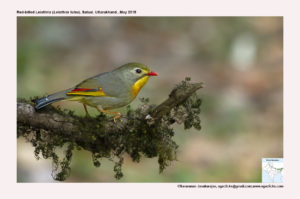
Red-billed Leiothrix Leiothrix lutea
Etymology:
- Leiothrix : Greek word Leio- Smooth ; thrix – Hair
- Lutea: Latin word for “ Saffron -yellow”
It is a widely sold caged bird and has many alternative names like Japanese Robin, Pekin Robin, Pekin Nightangle
Distribution in India: Resident in Himalayas and North East of India
Description: Size of 14–15 cm; wt. of 18–28 g. It is a small olive-grey babbler with forked tail, red bill, yellow throat, orange-yellow breast, and red to yellow wing markings. The male of nominate race has yellowish-olive crown, shading slowly on nape to mouse-grey upperparts, with very long, whitish-tipped uppertail-coverts. The upperwing has yellow and orange-yellow fringing and large chestnut-red basal patch on primaries, small yellow patch at base of outer secondaries, tail is glossy black; lores and orbital area are yellowish-buff , pale buffish-grey ear-coverts, olive to blackish-olive submoustachial stripe turning grey under ear-coverts and on neck sides. It has strong yellow on chin and throat shading to orange-rufous on upper breast, pale yellow on mid-breast to vent, pale olive-grey flanks. The iris is dark brown to crimson; bill is coral-red with black base. The legs are greenish-yellow to pale brown. The female is slightly smaller than male, with more greenish-olive crown, greyer ear-coverts, duller and smaller reddish wing patch. The juvenile is similar to female, but has paler bill, crown concolorous with mantle, with underparts olive-grey and whitish in center. Race kumaiensis has greener crown with more restricted yellowish wash than nominate, little or no chestnut-red wing patch but orange-red distal outer fringes of inner primaries, patch at base of secondaries is orange; race calipyga is similar to previous but yellower above, orange-red fringes of inner primaries extending entire length of feathers.
Habitat: It is found in thick undergrowth in more open broadleaf evergreen, pine and mixed forests, forest edge, secondary growth, scrub including shrub verbena, also abandoned cultivation, tea plantations, bamboo clumps. It is found throughout range at 750–3400 m
Food Habits: They are omnivores, feeding on grains and seeds, fruits like banana, strawberry, guava & Papaya. They also feed on various species of Diptera, Mollusca, Lepidoptera, and Hymenoptera. Its food is usually gathered from foliage and dead wood and it usually searches for food in lower strata of vegetation. It occasionally ascends trees, gleaning and plucking items, sometimes hanging upside-down, and frequently making short aerial leaps to snatch flying insects.
Breeding Habits: They breed in Apr–Oct in India, May to Aug in Bhutan. They are multi-brooded. The nest is built mostly by female, male supplies the material. The nest is, a regular or oval cup, of varying depth and solidity, made of fine and coarse grasses, dead bamboo and other leaves, leaf skeletons, moss, lichen and fine pieces of rattan, lined with fine rootlets, fine grasses, palm and other soft fibers, tendrils and fern stems, placed above ground in bush or bamboo. They lay a clutch of 3–5 eggs. The incubation is done by both parents, mainly female. The incubation period is 12–14 days. The nestlings are provisioned by both parents.